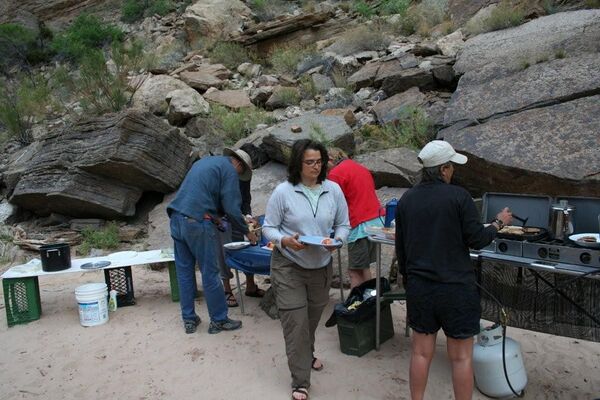The Food Pack
This chapter includes info on how to arrange meal responsibilities, food lists, coffee, perishable storage, cooler type and packing, lunch logistics (equipment, beach, floating, and hiking lunch), winter vs summer, time to prepare food on river, drinks (hot/cold/alcohol), and cooler ice maintenance.
In the shared work environment that is unique to do-it-yourself trips, it is imperative to give ample thought to assigning responsibilities for meal planning, purchasing, packing and preparation.
Start with planning the emergency food for the trip. Meriwether Lewis of the Lewis and Clark expedition purchased 200 pounds of portable soup which he called "one of the most essential articles" for their trip. Like the Lewis and Clark expedition it is necessary to prepare for the unexpected such as a raft flip where food is lost or a horde of hungry people showing up for a meal and not having enough food. Emergency food should be light, not take up a lot of space and be easy to prepare quickly. This can be freeze-dried food or instant food that can be found in a grocery store that just requires adding hot water. For a meal where the amount is going to fall short something can be pulled out of the emergency food and quickly prepared to supplement the meal. Instead of every meal having to provide enough food so that there is no risk of running short and probably carrying a lot of wasted food that is heavy and take up a lot of space the emergency food will save on weight and space. Since emergency food is small and light a large amount can be brought along. Hopefully it will rarely be needed and, since it is likely to keep for a long time, that is okay and it can used for something else like an another outdoor adventure.
Most breakfasts and lunches should not take a lot of time to prepare. Meals that require a lot of work should be saved for camp in the evening but there should be some dinners that can be prepared quickly in case of arriving late to camp doe to a planned long day, an unplanned event like a raft flip or having to row farther than planned because a camp is already occupied.
Some groups like to organize food by day and others organize similar items together. Probably most groups use both approaches but tend towards one or the other. But it is best to be clear about your approach to organizing the food pack. Switching from one approach to another the day before a trip has led to chaos during the trip.
Click here to return to The Pre-Trip Planning page.
